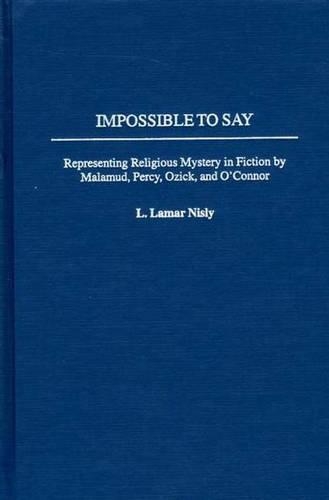
Impossible to Say: Representing Religious Mystery in Fiction by Malamud, Percy, Ozick, and O'Connor
(Hardback)
Publishing Details
Impossible to Say: Representing Religious Mystery in Fiction by Malamud, Percy, Ozick, and O'Connor
By (Author) L. Lamar Nisly
Bloomsbury Publishing PLC
Praeger Publishers Inc
30th June 2002
United States
Classifications
Tertiary Education
Non Fiction
Literary studies: c 1900 to c 2000
Religion and beliefs
Social groups: religious groups and communities
Regional / International studies
813.5409382
Physical Properties
Hardback
164
Width 156mm, Height 235mm
425g
Description
Links the Jewish fiction of Malamud and Ozick with the Catholic fiction of Percy and O'Connor to study the representation of religious mystery in works by these authors. Although Judaism and Catholicism have important differences, both religions contain elements of religious mystery, aspects of belief that transcend the rational. Each religion additionally provides believers a concrete method for encountering the numinous: following the commandments in Judaism or partaking of the sacraments in Catholicism. This book studies how Jewish and Catholic practices of giving structure to religious mystery are embodied in the works of Bernard Malamud, Walker Percy, Cynthia Ozick, and Flannery O'Connor. The volume links Malamud with Percy and Ozick with O'Connor because these Jewish and Catholic authors depict religious mystery in similar ways. Percy and Malamud use the quest form to give shape to mystery. In doing so, they show their characters moving toward a religious commitment. In contrast, O'Connor and Ozick use the grotesque and fantastic to evoke the numinous. Thus they embody the religious mystery that Malamud's and Percy's characters seek to encounter. Whether presenting a movement toward mystery or serving to evoke it, these four authors explore an ineffable dimension that readers need to sense in order to gain a better understanding of their works.
Reviews
[R]aises interesting questions about how much of the impossible O'Connor was able to do as an artist....While O'Connor scholars will not find in this book radically new reding of the four o'Connor stories Nisly analyses, they will see interesting questions about the extent to which O'Connor's writing techniques can be considered inherently and specifically Catholic....The major virtue of this book is in what it suggests for future investigations about religious writers of contrasting religious commitments.-Flannery O'Connor Review
"Raises interesting questions about how much of the impossible O'Connor was able to do as an artist....While O'Connor scholars will not find in this book radically new reding of the four o'Connor stories Nisly analyses, they will see interesting questions about the extent to which O'Connor's writing techniques can be considered inherently and specifically Catholic....The major virtue of this book is in what it suggests for future investigations about religious writers of contrasting religious commitments."-Flannery O'Connor Review
"[R]aises interesting questions about how much of the impossible O'Connor was able to do as an artist....While O'Connor scholars will not find in this book radically new reding of the four o'Connor stories Nisly analyses, they will see interesting questions about the extent to which O'Connor's writing techniques can be considered inherently and specifically Catholic....The major virtue of this book is in what it suggests for future investigations about religious writers of contrasting religious commitments."-Flannery O'Connor Review
Author Bio
L. LAMAR NISLY is Associate Professor of English at Bluffton College. He has published in such journals as Studies in American Jewish Literature and Journal for Peace and Justice Studies.
